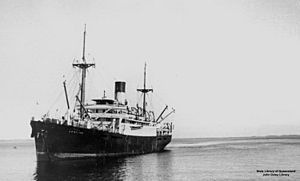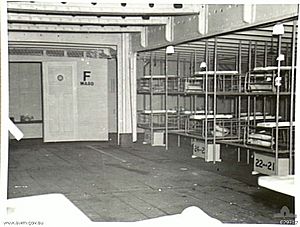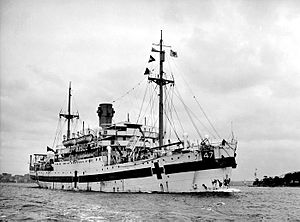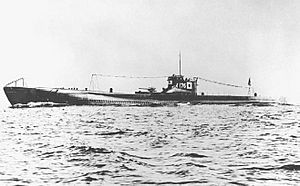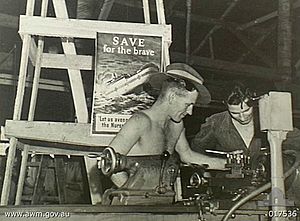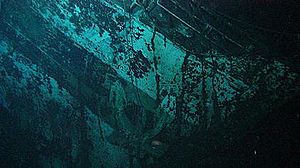AHS Centaur facts for kids
class="infobox " style="float: right; clear: right; width: 315px; border-spacing: 2px; text-align: left; font-size: 90%;"
| colspan="2" style="text-align: center; font-size: 90%; line-height: 1.5em;" | 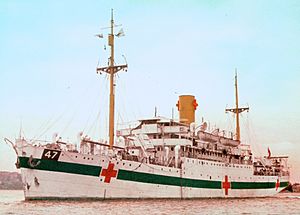
|}
The Australian Hospital Ship (AHS) Centaur was a special ship used to carry sick and wounded people. It was attacked and sunk by a Japanese submarine near Queensland, Australia, on 14 May 1943. Out of 332 medical staff and crew on board, 268 people died. This included 63 of the 65 army medical staff.
The Centaur was built in Scotland in 1924. It started as a ship that carried both passengers and refrigerated cargo. It sailed between Western Australia and Singapore, stopping in places like the Dutch East Indies (now Indonesia). It carried people, goods, and even livestock. When World War II began, Centaur was put under the control of the British Navy. It was given some defensive weapons but continued its normal trips. In November 1941, the ship rescued German sailors after a battle between their ship, the Kormoran, and the Australian warship HMAS Sydney. In October 1942, Centaur moved to Australia's east coast. It then helped transport supplies to New Guinea.
In January 1943, the Australian military took over Centaur. They decided to turn it into a hospital ship. Its smaller size made it good for working in the shallow waters of Maritime Southeast Asia. The ship was repainted white with a green stripe and three red crosses, showing it was a hospital ship. This was finished in March. The Centaur then made a test trip, carrying wounded soldiers from Townsville to Brisbane, and then from Port Moresby to Brisbane. After getting more supplies in Sydney, Centaur picked up soldiers from the 2/12th Field Ambulance to take them to New Guinea. It sailed on 12 May. Early on 14 May 1943, during its second trip as a hospital ship, Centaur was hit by a torpedo and sank quickly off Moreton Island, Queensland. Most of the 332 people on board died. The 64 survivors were found 36 hours later. This attack caused a lot of anger because attacking a hospital ship is a war crime under international rules. Australia and Britain protested to Japan. In the 1970s, it became likely that the Japanese submarine I-177 was responsible for the attack.
The reason for the attack is still not fully known. Some ideas are that Centaur might have broken international rules, or that the submarine commander didn't know it was a hospital ship. Another idea is that the commander knew it was a hospital ship and attacked it anyway. The wreck of Centaur was found on 20 December 2009. A previous claim in 1995 turned out to be a different shipwreck.
Contents
| History | |
|---|---|
| Name | Centaur |
| Namesake | The Greek mythological creature |
| Owner | Ocean Steamship Company |
| Operator | Alfred Holt & Co Ltd (Blue Funnel Line) |
| Ordered | 1923 |
| Builder | Scotts Shipbuilding and Engineering Company, Greenock |
| Laid down | 16 November 1923 |
| Launched | 5 June 1924 |
| Completed | 29 August 1924 |
| Homeport |
|
| Identification | United Kingdom Official Number 147275 |
| Fate | Transferred to Australia |
| General characteristics as merchant vessel | |
| Tonnage | 3,222 gross tonnes |
| Length | 96 m (315 ft) |
| Beam | 14.7 m (48 ft) |
| Draught | 6.1 m (20 ft) |
| Propulsion | Single screw; 4-stroke, 6-cylinder Burmeister and Wain diesel oil engine providing 1,400 bhp (1,000 kW) |
| Speed | 12.5 knots (23.2 km/h; 14.4 mph) |
| Capacity |
|
| Crew | 39 officers, 29 ratings |
| Armament |
|
| Name | Centaur |
| Operator | 2nd Australian Imperial Force |
| Acquired | 4 January 1943 |
| Reclassified | Hospital ship |
| Homeport | Sydney, New South Wales |
| Identification | Red Cross Ship 47 |
| Fate | Torpedoed on 14 May 1943 by Japanese submarine I-177 |
| General characteristics as hospital ship | |
| Capacity | 252 bed-patients |
| Crew | 75 crew, 65 permanent Army medical staff |
| Armament | All weapons removed, degaussing equipment remained |
Building and Changing the Ship
Original Design
In 1923, a shipping company called Ocean Steamship Company decided they needed a new ship. This ship would replace an older one on the route between Western Australia and Singapore. The new ship needed to carry passengers, cargo, and even animals. It also had to be able to sit on mud flats when the tide was low in some ports.
Scotts Shipbuilding and Engineering Company in Greenock, Scotland, was chosen to build the Centaur. Its construction began on 16 November 1923, and it was ready by 29 August 1924. The ship cost about £146,750. Centaur was designed to carry 72 passengers and 450 cattle. It had four cargo areas. The two decks inside the ship were mainly for livestock, but could also hold more cargo. The ship's hull was designed to be wider below the waterline and flat at the bottom. This allowed it to rest safely on the seabed. Centaur was one of the first civilian ships to use a diesel engine. It had a very tall smokestack, which was more for looks than for actual use on a diesel ship. One of its cargo holds had refrigeration to keep things cool.
In December 1939, Centaur had some small upgrades in Hong Kong. Its engine got a supercharger and a new propeller. But the supercharger broke down in April 1942. It could not be fixed because of the war.
Becoming a Hospital Ship
At the start of 1943, the Centaur was given to the Australian military. They wanted to change it into a hospital ship. This work was done in Melbourne, Australia.
The cost of changing the ship grew from AU£20,000 to almost AU£55,000. This was because more facilities were needed. The ship was originally meant to travel between New Guinea and Townsville, Queensland. But with more wounded soldiers from the New Guinea campaign, longer trips to Sydney were needed. The Army asked for more bathrooms, hot water, and better ventilation for tropical weather. The ship's crew also asked for better living and dining areas.
When AHS Centaur was ready on 12 March 1943, it had an operating room, a medicine room, two wards (where the cattle used to be), and a dental office. It also had living areas for 75 crew members and 65 army medical staff. To keep the ship balanced, 900 tons of iron were added to the cargo holds. AHS Centaur could travel for 18 days before needing supplies. It could carry over 250 patients who needed to stay in bed.
Ship's Journeys
Early Years (1924-1938)
When Centaur started service in late 1924, its main route was from Fremantle to Java and Singapore. It stopped at many ports along the Western Australian coast. Centaur was like a mix of a cargo ship and a passenger ship. It followed a set route, but its stops at ports could change. In November 1938, a big event happened. Centaur rescued a Japanese whale-hunting ship called Kyo Maru II. This ship had engine problems and was drifting towards dangerous reefs. Centaur towed it safely to Geraldton.
World War II (1939-1942)
When World War II started in September 1939, Centaur was given defensive weapons. These included a large gun at the back and two machine guns. It also had equipment to protect against naval mines. These weapons were removed when it became a hospital ship. Centaur continued its usual trade route at first.
On 26 November 1941, Centaur found a lifeboat with 62 German sailors. They were survivors from the German ship Kormoran, which had battled HMAS Sydney. Centaurs captain decided to tow the lifeboat and took nine wounded Germans on board. Later, two of Centaurs own lifeboats were used to carry the Germans. They were taken to Carnarvon, Western Australia. From there, Centaur took them and other Kormoran survivors to Fremantle.
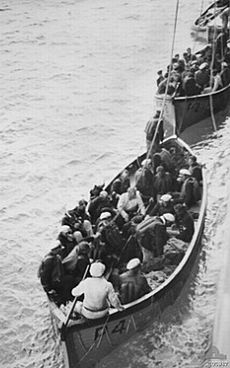
After Japan attacked Pearl Harbor in December 1941, Centaur's route was shortened. On 6 October 1942, Centaur was sent to Queensland. It then started carrying supplies between Australia's east coast and New Guinea.
Hospital Ship Role (1943)
By early 1943, Australia needed more hospital ships. The existing ones were too big for the shallow waters near Maritime Southeast Asia. So, Centaur was chosen. It was converted in Melbourne. The conversion began on 9 January, and Centaur became an Australian Hospital Ship on 1 March. During its conversion, Centaur was painted white with a green band and three red crosses on each side. It also had large red crosses on its top. These markings showed it was a hospital ship and should not be attacked. It also had the number "47" on its front. At night, these markings were lit up. Information about the ship's markings was sent to the International Committee of the Red Cross. They passed it on to the Japanese on 5 February 1943.
Centaur began operating as a hospital ship on 12 March 1943. Its first trips were tests and transport runs. It carried wounded soldiers from Townsville to Brisbane. Then it took medical staff to Port Moresby, New Guinea. It returned to Brisbane with Australian and American wounded, and some wounded Japanese prisoners.
On 8 May 1943, Centaur arrived in Sydney. It was resupplied before leaving for Cairns, Queensland, on 12 May 1943. Its next stop was New Guinea. On board were 74 civilian crew, 53 Australian Army Medical Corps staff (including 8 officers), 12 female nurses, 192 soldiers from the 2/12th Field Ambulance, and a ship pilot. Most of the nurses had come from another hospital ship, the Oranje. The male army staff were all medical personnel. During loading, some ambulance drivers tried to bring their rifles and ammunition on board. This worried the crew and workers. They thought Centaur might be carrying military supplies, which was not allowed for a hospital ship. The rifles were only allowed after the captain was told that ambulance drivers could carry weapons for order and defense of the wounded. The rest of the cargo was checked for other weapons.
The Sinking
Around 4:10 AM on 14 May 1943, while on its second trip from Sydney to Port Moresby, Centaur was hit by a torpedo from a submarine that was not seen. The torpedo hit the left side of the ship, making a large hole. The fuel caught fire, and the ship was burning from the bridge backwards. Many people on board died right away from the blast or the fire. Centaur quickly filled with water, tilted to the left, and then sank bow-first. It was completely underwater in less than three minutes. The ship sank too fast for lifeboats to be launched. However, two lifeboats and some damaged rafts broke free as the ship went down.
The attack happened about 24 nautical miles (44 km) east-northeast of Point Lookout, Queensland. This location was later confirmed when the wreck was found in 2009.
Survivors
| Survivor breakdown | ||
|---|---|---|
| Group | Embarked | Survived |
| Crew | 75 | 30 |
| Army officers | 8 | 0 |
| Army nurses | 12 | 1 |
| 2/12th Field Ambulance | 192 | 32 |
| Other Army | 45 | 1 |
| Total | 332 | 64 |
Out of 332 people on board, only 64 were saved. Most of the crew and passengers were asleep when the attack happened, so they had little chance to escape. It's thought that up to 200 people might have been alive when Centaur went under. Some who got off the ship later died from injuries or burns. Others drowned because they couldn't find anything to hold onto.
The survivors spent 36 hours in the water. They used barrels, wreckage, and two damaged lifeboats to stay afloat. During this time, they drifted about 19.6 nautical miles (36 km) northeast of where Centaur sank. They were spread out over an area of about 2 nautical miles (3.7 km). The survivors saw at least four ships and several aircraft, but they couldn't get their attention.
When they were rescued, the survivors were in two large groups and three smaller ones. Among those saved were Sister Ellen Savage, the only nurse out of 12 to survive. Leslie Outridge was the only doctor out of 18 to survive. Gordon Rippon was the second officer and the highest-ranking crew member who survived. Richard Salt was the ship pilot. In 1944, Ellen Savage received the George Medal for her bravery and for helping others while waiting for rescue.
Rescue Efforts
On the morning of 15 May 1943, the American destroyer USS Mugford left Brisbane. It was escorting a New Zealand cargo ship called Sussex. At 2:00 PM, a lookout on Mugford saw something on the horizon. Around the same time, a Royal Australian Air Force plane flew down towards the object. The plane then signaled to the two ships that there were shipwreck survivors in the water. Mugford's captain told Sussex to continue alone. Mugford then went to pick up the survivors. Sailors stood ready to shoot sharks, and others were ready to jump in to help the wounded. Medics on Mugford checked each person as they came aboard and gave them medical care. The American crew learned from the first group of survivors that they were from the hospital ship Centaur.
At 2:14 PM, Mugford contacted the Naval Officer-in-Charge in Brisbane. It announced that it was rescuing survivors from Centaur. This was the first time anyone in Australia knew about the attack on the hospital ship. Rescuing the 64 survivors took an hour and twenty minutes. Mugford stayed in the area until dark, searching for more survivors. After dark, Mugford returned to Brisbane. Other ships also searched the waters for more survivors, but none were found.
Finding the Attacker
At the time of the attack, no one on Centaur saw what hit the ship. Because of the ship's location and the depth of the water, it was believed that a Japanese submarine had torpedoed it. Several survivors later said they heard the submarine moving on the surface. The ship's cook, Francis Martin, who was floating alone, even saw the submarine. He described it to Naval Intelligence. His description matched a type of Japanese submarine called a KD7 Kaidai-class submarine.
At the time of the attack, three KD7 Kaidai submarines were operating near Australia's east coast. These were I-177, I-178, and I-180. None of these submarines survived the war.
In December 1943, after official protests, the Japanese government said they were not responsible for sinking Centaur. After the war, Japanese records also did not admit responsibility. Even though sinking Centaur was a war crime, no one was ever tried for it. Investigations were done between 1944 and 1948. They questioned the commanders and crew of the submarines. Some investigators thought that Hajime Nakagawa and I-177 were most likely responsible. But they couldn't prove it for sure. The Centaur case was closed on 14 December 1948 without anyone being charged.
Historians had different ideas about which submarine was responsible. In 1972, a German historian named Jürgen Rohwer said that I-177 torpedoed Centaur. This was based on a Japanese report. Later, a Japanese Rear Admiral, Kaneyoshi Sakamoto, also said that Nakagawa and I-177 were responsible. Because Sakamoto's work was an official history of the Japanese Navy, most people then believed that Nakagawa and I-177 were indeed responsible for the loss of Centaur. Nakagawa, who died in 1991, never spoke about the attack after the war.
How People Reacted
Public Reaction
The news of Centaur's sinking was released to the public on 18 May 1943. It made headlines around the world. This attack caused a lot of anger. As a hospital ship, Centaur was protected by international rules. Attacking it was a war crime. Both Australian Prime Minister John Curtin and General Douglas MacArthur strongly condemned the sinking. Curtin called it "an entirely inexcusable act." MacArthur said it showed Japanese "limitless savagery." Politicians urged people to use their anger to help the war effort. Centaur became a symbol of Australia's strong will to defeat the enemy. The Australian Government made posters showing the sinking. They called for Australians to "Avenge the Nurses" by working hard, buying war bonds, or joining the armed forces.
People also felt great sympathy for the crew. There were efforts to raise money for a new hospital ship. Some people who worked on Centaur's conversion donated money. Employees of Ansett Airways promised to donate an hour's pay.
Some people found it hard to believe that the Japanese would be so cruel. Rumors started that Centaur had been secretly carrying weapons or soldiers. This rumor came from the incident where ambulance drivers tried to bring their rifles on board.
Military Reaction
Australian soldiers were very angry about the attack. They believed it was done on purpose, knowing Centaur was a hospital ship. Other Allied soldiers felt the same way. An American general even had to stop a sergeant from bombing a Japanese hospital ship in revenge.
Six days after the attack, Australia asked for the markings and lights to be removed from another Australian hospital ship, Manunda. They wanted to add weapons and have it sail in darkness with an escort. This was done, but later reversed after protests from other countries. This change cost £12,500 and kept Manunda out of service for three months. It was decided that the attack on Centaur was likely the act of one irresponsible Japanese commander. It was better to wait for more attacks before removing hospital ship markings from all ships.
The incident with the ambulance drivers' weapons led to stricter rules. Only medical staff were allowed on hospital ships. Ambulance drivers had to officially join the Australian Army Medical Corps to be allowed on board. They could still carry their unloaded weapons.
Official Protests
After talking with the Australian military and government, an official protest was sent to Japan. Japan received it on 29 May 1943. The International Committee of the Red Cross also sent a protest to the Japanese Red Cross.
On 26 December 1943, Japan replied to Australia's protest. They said they had no information to support the claim and took no responsibility. Japan also claimed that nine of their hospital ships had been attacked by the Allies. Even after more messages were exchanged, no progress was made. On 14 November 1944, the British Government told Australia that no more messages would be sent about the loss of Centaur.
Why Was it Attacked?
Torpedo attacks were common in Australian waters during this time. Japanese submarines were trying to stop supply ships going from Australia to New Guinea.
Some actions by Centaur itself might have played a role. Centaur was ordered to sail far out to sea. But its captain chose a course closer to land. Also, Centaur was fully lit up, except for two lights at the front. These lights were turned off because they made it hard to see from the bridge.
There are three main ideas about why Centaur was attacked:
A Valid Target?
This idea comes from rumors that spread after the sinking. If Centaur had broken the Hague Convention of 1907 rules, and someone told the Japanese, then I-177 might have been ordered to attack. When Centaur left Sydney, its decks were full of men in green uniforms. From a distance, it might have looked like the ship was carrying soldiers. People who saw the loading might have seen the ambulance drivers with their weapons. They could have thought the ship was carrying military supplies. If a spy told this to the Japanese, I-177 might have been waiting. But this idea has a problem: how would the submarine know Centaur was taking a different route?
Other rumors said that on its first trip, Centaur had carried soldiers or Japanese prisoners of war back to Australia for questioning. This would make it a valid target. However, Centaur did carry 10 wounded prisoners of war. But carrying wounded prisoners on a hospital ship was allowed by law.
A Mistake?
This idea says that the submarine commander, Nakagawa, didn't know he was attacking a hospital ship. It was an accident. Some Japanese officers supported this view. For example, Lieutenant Commander Zenji Orita, who later commanded I-177, said he never heard any rumors from the crew about sinking a hospital ship. He believed if they had known, he would have heard about it.
Compared to other Australian hospital ships, Centaur was the smallest. It was about one-third the size of Manunda or Wanganella. Centaur was also slightly shorter than I-177. The submarine would have seen Centaur through a periscope. At 1500 meters (about 1 mile), which was the best attack range for Japanese submarines, some officers might not clearly see a ship's shape or markings. With Centaur's front lights off, and looking through a periscope, Nakagawa might not have seen the hospital ship markings. However, apart from those two lights, Centaur was brightly lit. To attack, I-177 would have had to approach from the side of Centaur, which was lit by its own lights and a full moon.
An Intentional Attack?
This idea suggests that Nakagawa knew his target was a hospital ship and decided to sink it anyway. He might have done this on his own, or misunderstood his orders. Some researchers think Nakagawa was nearing the end of his patrol and had only sunk one enemy ship. He might not have wanted to return with only one kill. Other ideas are that Nakagawa might have been seeking revenge for losses caused by the Allies. He might have also expected praise for sinking an enemy naval vessel.
In February 1944, while commanding another submarine, I-37, Nakagawa ordered his crew to machine-gun survivors from three British merchant ships. He said he was following orders, but this was not accepted. He was sentenced to four years in prison for these actions. These events showed that Nakagawa was willing to ignore the laws of war.
The Shipwreck
After World War II, many searches were done for Centaur near North Stradbroke and Moreton Islands. But they couldn't find it. People thought it had sunk off the edge of the continental shelf, too deep for the Royal Australian Navy to search. Some also believed that the calculated sinking point was wrong.
Several places were wrongly identified as Centaur's location. In 1995, a man named Donald Dennis claimed he found the wreck. He said it was 9 nautical miles (17 km) from Moreton Island. Footage of the wreck was shown on TV. Dennis claimed the Navy and museums had confirmed it. The Navy did a quick search and confirmed a wreck was there. It was then marked as a war grave.
Over the next eight years, doubts grew about Dennis's claim. The location was far from where survivors were found. Dennis had also been convicted of fraud. Two divers, Trevor Jackson and Simon Mitchell, explored the wreck in 2002. They said the ship was too small to be Centaur. Jackson believed it was actually a much smaller ship called MV Kyogle, which was sunk during bombing practice in 1951.
On the 60th anniversary of the sinking, a TV show proved that the wreck was not Centaur. Experts said the shipwreck had different features, like a wrong rudder. After this, the Navy sent three ships to check the site. They confirmed that the shipwreck was not Centaur. The war grave status was then removed from that location.
Discovery
In April 2008, after the successful search for HMAS Sydney, people started calling for a search for Centaur. By the end of 2008, the Australian Federal and Queensland State governments put A$2 million each towards a search. The search began on 12–13 December 2009. The search team had 35 days to find and film the wreck.
Six possible targets were found between 15 and 18 December. On the afternoon of 18 December, the sonar equipment was lost in 1800 meters (5,900 ft) of water. The search team then used a different sonar. On 20 December, the search team announced they had found Centaur.
The wreck was found at 27°16.98′S 153°59.22′E / 27.28300°S 153.98700°E. This was about 30 nautical miles (56 km) east of Moreton Island. It was less than 1 nautical mile (1.9 km) from where Second Officer Rippon had calculated it sank. The ship rests 2059 meters (6,755 ft) below sea level in a deep gully. After a break for Christmas, the team returned to document the wreck. The first photos were taken by a special underwater robot on 10 January 2010. These photos confirmed it was Centaur. Over 24 hours of video and many photos were collected. They showed the Red Cross identification number, the hospital ship markings, and the ship's bell. The Centaur wreck site is now a war grave and is protected.
Memorials
In 1948, nurses in Queensland started the "Centaur Memorial Fund for Nurses." They used money raised to buy a building called "Centaur House." This place helped nurses by holding meetings and providing cheap housing. The first Centaur House was sold in 1971, and a new one was bought. This second Centaur House was sold in 1979. The fund still exists, but it no longer owns a building. On 15 September 1968, a stone monument was unveiled in Caloundra, Queensland. In 1990, a stained glass window showing Centaur was put in Concord Repatriation General Hospital. It also had a plaque listing the names of those lost. A display about Centaur was also at the Australian War Memorial. It had a model of the ship and items donated by survivors.
A memorial to Centaur was unveiled at Point Danger, Coolangatta, Queensland, on 14 May 1993. This was the 50th anniversary of the sinking. It is a large stone with a small monument on top. It is surrounded by a tiled area with plaques explaining the memorial. The memorial is in a park overlooking the sea. It also has plaques for other ships lost in World War II.
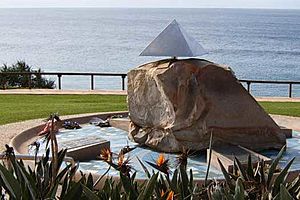
A memorial plaque was placed on the front deck of Centaur on 12 January 2010. This happened during the last underwater robot dive on the ship. Normally, this would not be allowed, but special permission was given. If the plaque was placed on the seabed, it would sink into the mud. After the ship was found, a national memorial service was held at St John's Cathedral, Brisbane, on 2 March 2010. Over 600 people attended, including Prime Minister Kevin Rudd. A second ceremony was held for 300 relatives of the ship's personnel. This was on board HMAS Manoora on 24 September. During this service, which was held over the wreck site, wreaths were laid. The ashes of three survivors were also scattered.
See also
 In Spanish: AHS Centaur para niños
In Spanish: AHS Centaur para niños


